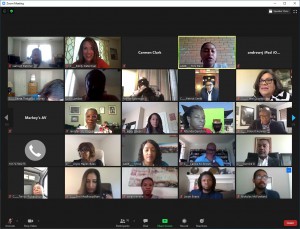 PESA Vice President Strategy and Programs Molly Determan led an executive coaching session at the American Association of Blacks in Energy’s Virtual Energy Re-Imagined Conference on August 20.
PESA Vice President Strategy and Programs Molly Determan led an executive coaching session at the American Association of Blacks in Energy’s Virtual Energy Re-Imagined Conference on August 20.
The session created engaging, free flowing and impactful dialogue. Executives offered coaching and facilitated conversations about topics important to energy professionals seeking to energize the future for customers and communities. Executives also shared leadership principles and insights they believe will be important to emerging policies, technology advancements, innovative solutions and partnerships designed to create a sustainable future in energy.
Determan provided six tips for leading a team in successfully executing on a strategic goal:
1. Clear direction: Let everyone in on the strategy and vision. Ask for others’ input so they have buy-in. Then, make sure each team member knows their roles and responsibilities. It’s important for everyone to have a good idea of which decisions and actions fall into their area of responsibility. Poorly defined roles will lead to inactivity because of uncertainty about who’s responsible for what. It’s unrealistic to expect people to intuitively understand which decisions are theirs to make.
Providing a clear view of the overall strategy helps create a sense of urgency because team members will understand how short-term tactical goals fit within the structure of long-term strategic objectives. Leaders should understand this is not a one-time exercise. It’s best to maintain open lines of communication, and leaders shouldn’t hesitate to loop everyone in if they think it can help provide a greater understanding of long-term goals.
2. Setting expectations: Clearly communicating expectations for performance is an integral part of achieving an organization’s goals. One difficult aspect in this area can be holding people accountable. Team leaders need to ensure barriers to performance are addressed and provide people with the resources necessary to meet their goals.
Feedback should be provided frequently, and leaders will sometimes need to provide hard feedback. Teams respect when hard feedback is given fairly and consistently so they can move on and keep achieving goals.
3. Accountability: Manage the tension between giving autonomy to people to do their jobs and staying on top of execution. Within each team will be individuals who need differing levels of supervision. The accountability framework for all employees becomes stronger the more you can empower others to make decisions and drive results for themselves.
Don’t ask people to always come to you for problem-solving recommendations. Instead, encourage a culture that enables team members to work through issues and not rely on the leader to do their job. That just slows down execution.
4. Value driven: Be clear on what the values are, and that every team member is expected to uphold them. Then, continue to show how decisions being made are in line with the values. This keeps everyone grounded and on the same page.
5. Identify individual strengths to build the team. Leaders can sometimes fall into the trap of selecting team members who are similar to themselves. A wise leader looks for skills they don’t have but can contribute to accomplishing the strategic goal. Good teams have a diverse skillset and mindset. If everyone on the team thinks alike, the organization may never know what opportunities it missed.
6. Reward performance: Celebrating small wins helps grow momentum.




